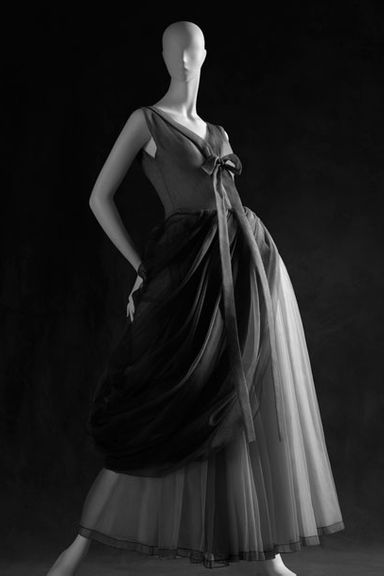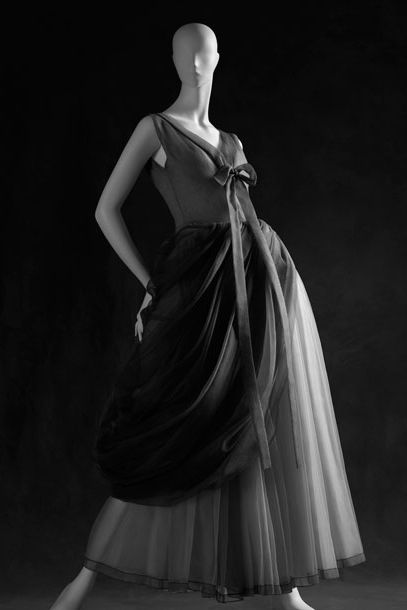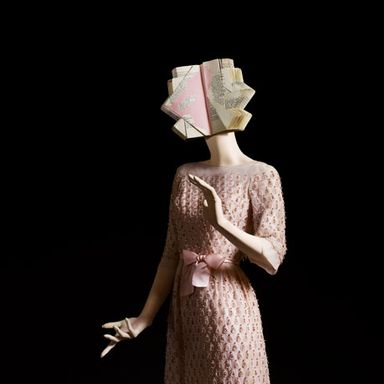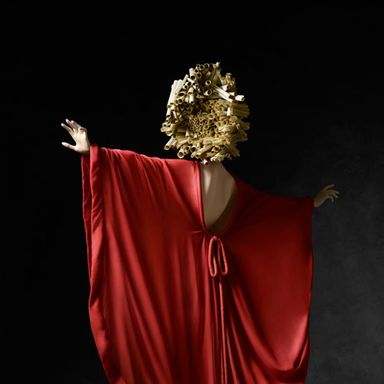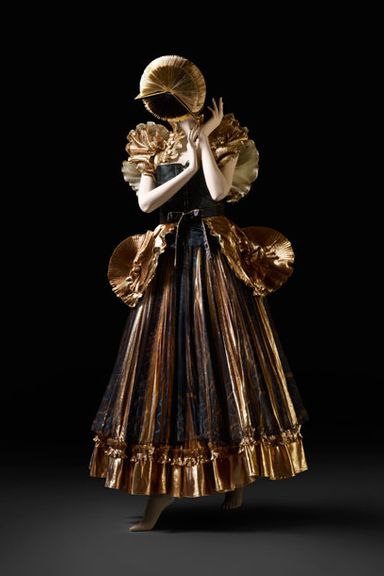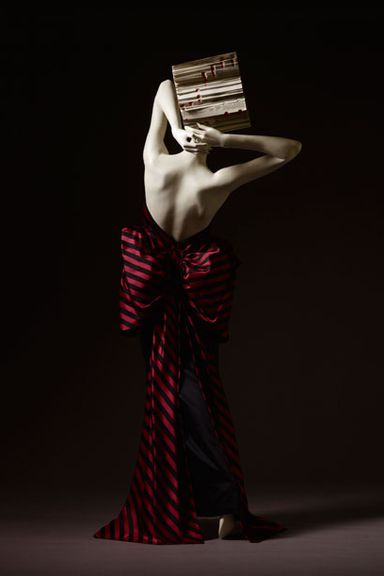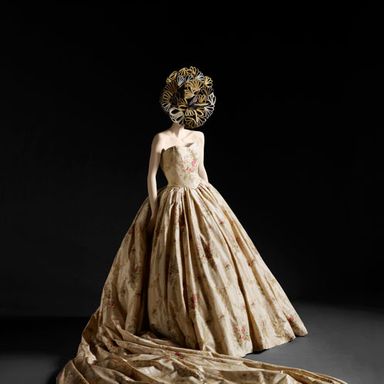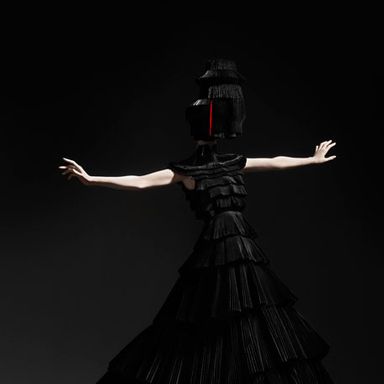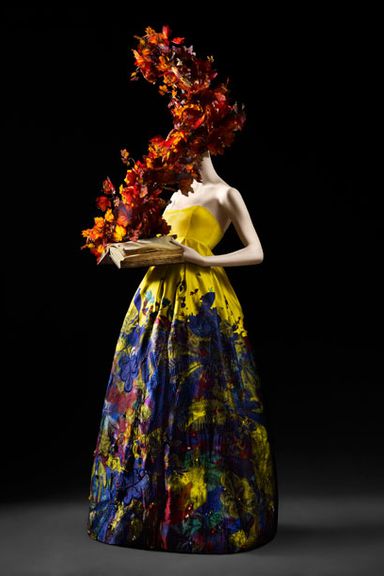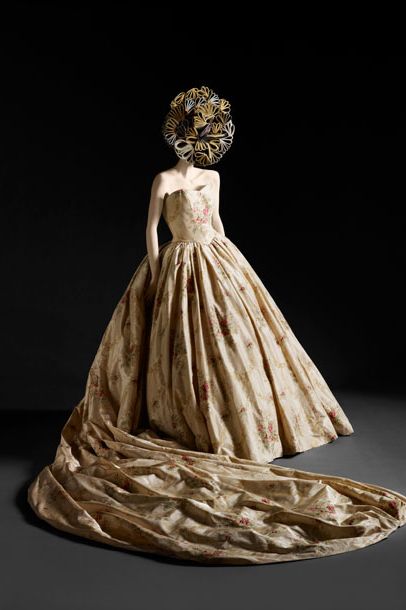First Look: The V&A’s Ballgowns: British Glamour Since 1950
From coronations and debutante balls to red carpets rife with celebrities, the ballgown has always played a large role in British fashion. In honor of the Diamond Jubilee in England, the Victoria and Albert Museum takes a look back at British eveningwear during Queen Elizabeth II’s reign in an exhibition and accompanying book, both titled Ballgowns: British Glamour Since 1950. Sonnet Stanfill, curator of twentieth-century and contemporary fashion at the V&A, and Oriole Cullen, curator of modern textiles and fashion at the museum, brought together more than 60 gowns dating from 1950 to the present, including the work of Alexander McQueen, Stella McCartney, Zandra Rhodes, and more. “Royalty does play a very big part in formal dressing,” says Cullen, referring to the exhibition theme. “There are often big state occasions where you see photographs of the Queen or members of the Royal family in very formal evening dress.” She adds that ballgowns are a particularly treasured item of clothing in society. “The Royals themselves are very good at wearing things and using them and wearing them again. They don’t have a throwaway approach to it, and I think that feeds down through society traditionally — there was this idea that you’re investing in something good, and you’ll get your use out of it.” The exhibition begins May 19 and runs to the first week of January next year, and the book, shot by fashion photographer David Hughes, will be sold at the V&A shop and online. Read ahead for more about the making of the tome, Stanfill and Cullen’s thoughts on ballgown culture today, and Kate Middleton’s influence in our interview. Plus, preview some of the outfits, with commentary from the curators, in our slideshow.
How did this exhibition come about?
Stanfill: I think the exhibition came about because we wanted to celebrate an aspect of British fashion in this Jubilee year and also the summer Olympics in London, and so a whole host of exhibitions and programs are taking place this year in the V&A that relate to strength of British design. But that’s why the exhibition is focused squarely on British eveningwear, and we’re looking at maybe more since the 1950s, because it covers the reign of Queen Elizabeth, and we have a wonderful, very large space to fill, so we chose objects in the collection that are particularly dramatic, and full silhouettes.
How did you select pieces? Did you know in advance what you wanted to feature?
Cullen: We have a wonderful collection of textiles and dresses here at the V&A — we have 100,000 objects in the collection — and so when we decided on the subject for our exhibition, we went down into our archives and really just went through all of the pieces for the period that we’re looking at — the last 60 years, really … So the early part of the exhibition is very much based around our own holdings, from 1950 until the early 2000s. And then the contemporary section is a wonderful celebration of pieces by contemporary London designers, and they’ve all very generously lent those pieces to our show. We singled out things that we thought were really spectacular or really summed up the work of the contemporary designer, and then we approached them and asked them if they’d be interested in a collaboration. And it was always a resounding “yes.”
Can you talk about the way the mannequins are set up with the intricate headpieces in the book?
Cullen: They won’t actually be in the show. The book was shot in conjunction with the fashion photographer David Hughes here at the V&A, and the idea was to look at interpreting the dresses in a new way, because, of course, we’re bound by all the limits of a historic collection — we have to take good care of the gowns and would never put them on a live model. But at the same time, we wanted to capture some sense of movement … and we’d looked at a book called Inventive Clothing, where Irving Penn had worked with Diana Vreeland at the Met, and they’d shot dresses on mannequins, and so David came up with the idea of working with prop designer Vincent Olivieri to create these very surreal headpieces, so it was sort of a move away from your typical stock museum-mannequin figure. The idea was [that the] museum is a place of learning, so he was very inspired by the idea of books as objects of learning and sources, and so all of the headdresses are created from books.
Did you use any specific books?
Cullen: They were all just secondhand books which were sourced by Vincent, the prop designer, and he made some wonderful creative pieces inspired by the artist Linda Watson, who does a lot of book art. So they did things like dip-dying pages to match dresses and rolling tiny scrolls to create headpieces and drilling through books — they were quite creative with what they were using.
What would you say is the most difficult part of the process?
Stanfill: I think one of the challenges, in terms of the visual look of the show, as you would imagine with the dresses — because they date from a very wide 60-year period where things changed dramatically, in terms of silhouette, color, surface decoration — it’s a real range of looks and styles that don’t necessarily look good together. And so, rather than look at themes or possibly displaying them chronologically, we decided to group the gowns by color, exploring the idea of how trends in color for eveningwear have changed over time. So, yeah, that was definitely a challenge, how to make all of these diverse designs look good together.
Cullen: It was really interesting, because we found that a lot of colors that tended to be popular would recur. We have a large case of pink ballgowns, I’m sure you’re not surprised to hear. But there were interesting colors, such as chartreuse green and some very deep blues and emerald greens which you might not necessarily think of, which cropped up again and again throughout the decades, so it was an interesting exercise in these particular colors that seem to go for.
Do you think ballgown culture has fallen by the wayside a bit these days?
Cullen: I think it’s really changed and developed a lot, we found over the years. So, from the initial 1950s, you have the queen’s coronation, which was watched all over the world by millions of people because it was the first televised coronation with lots of ballgowns … And then you still had the tradition of young debutante girls [that] were presented to the monarch up until 1958. Girls from “good” families would be presented at court. Obviously, that sort of changes when that stops in 1958, and you get a lot of private balls and parties, moving away in the eighties when the charity ball becomes very popular, and that’s something that anybody can attend if you can afford the price of the ticket, so it’s more democratic. And certainly to today’s red carpet, which I think is really important and very key for a lot of designers, so I think that keeps the formal gown very relevant and very much part of a lot of designers’ collections.
What do you think the duchess of Cambridge has done for British fashion?
Cullen: Well, I think it’s interesting, you can sort of trace it right back to Queen Victoria, it’s often with women who are young, attractive, and royal, there is a real fascination. And, of course, Princess Diana in the 1980s was really a global style icon, people really watched to see what she was wearing. Kate Middleton has a very modern approach to what she wears, she sort of has always been a great advocate of the British high street, and she didn’t change overnight when she married, she continued to dress as she had … So I think she’s really very stylish, and of course, we also have to remember that there’s a lot of royal protocol that she really has to make sure that she’s dressing — you know, she doesn’t have free reign, she can’t just pick something off the rack and say, “Great, this’ll do.” It has to tick a lot of boxes when you’re in the public eye and you’re meeting lots of people and you’re on your feet for a long time — there are so many considerations, so I think she manages to balance it very well.
